
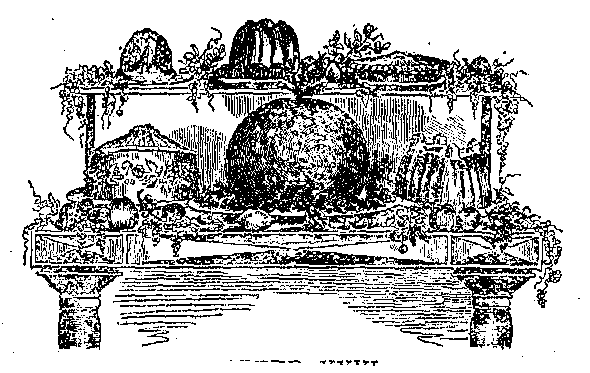
1175.
PUDDINGS AND PASTRY, familiar as they may be, and unimportant as they may be held in the estimation of some, are yet intimately connected with the development of agricultural resources in reference to the cereal grasses. When they began to be made is uncertain; but we may safely presume, that a simple form of pudding was amongst the first dishes made after discovering a mode of grinding wheat into flour. Traditional history enables us to trace man back to the time of the Deluge. After that event he seems to have recovered himself in the central parts of Asia, and to have first risen to eminence in the arts of civilization on the banks of the Nile. From this region, Greece, Carthage, and some other parts along the shores of the Mediterranean Sea, were colonized. In process of time, Greece gave to the Romans the arts which she had thus received from Egypt, and these subsequently diffused them over Europe. How these were carried to or developed in India and China, is not so well ascertained; and in America their ancient existence rests only on very indistinct traditions. As to who was the real discoverer of the use of corn, we have no authentic knowledge. The traditions of different countries ascribe it to various fabulous personages, whose names it is here unnecessary to introduce. In Egypt, however, corn must have grown abundantly; for Abraham, and after him Jacob, had recourse to that country for supplies during times of famine.1176.
THE HABITS OF A PEOPLE, to a great extent, are formed by the climate in which they live, and by the native or cultivated productions in which their country abounds. Thus we find that the agricultural produce of the ancient Egyptians is pretty much the same as that of the present day, and the habits of the people are not materially altered. In Greece, the products cultivated in antiquity were the same kinds of grains and legumes as are cultivated at present, with the vine, the fig, the olive, the apple, and other fruits. So with the Romans, and so with other nations. As to the different modes of artificially preparing those to please the taste, it is only necessary to say that they arise from the universal desire of novelty, characteristic of man in the development of his social conditions. Thus has arisen the whole science of cookery, and thus arose the art of making puddings. The porridge of the Scotch is nothing more than a species of hasty pudding, composed of oatmeal, salt, and water; and the "red pottage" for which Esau sold his birthright, must have been something similar. The barley-gruel of the Lacedaemonians, of the Athenian gladiators and common people, was the same, with the exception of the slight seasoning it had beyond the simplicity of Scottish fare. Here is the ancient recipe for the Athenian national dish:-- "Dry near the fire, in the oven, twenty pounds of barley-flour; then parch it; add three pounds of linseed-meal, half a pound of coriander-seed, two ounces of salt, and the quantity of water necessary." To this sometimes a little millet was added, in order to give the paste greater cohesion and delicacy.1177.
OATMEAL AMONGST THE GREEKS AND ROMANS was highly esteemed, as was also rice, which they considered as beneficial to the chest. They also held in high repute the Irion, or Indian wheat of the moderns. The flour of this cereal was made into a kind of hasty pudding, and, parched or roasted, as eaten with a little salt. The Spelt, or Red wheat, was likewise esteemed, and its flour formed the basis of the Carthaginian pudding, for which we here give the scientific recipe:-- "Put a pound of red-wheat flour into water, and when it has steeped some time, transfer it to a wooden bowl. Add three pounds of cream cheese, half a pound of honey, and one egg. Beat the whole together, and cook it on a slow fire in a stewpan." Should this be considered unpalatable, another form has been recommended. "Sift the flour, and, with some water, put it into a wooden vessel, and, for ten days, renew the water twice each day. At the end of that period, press out the water and place the paste in another vessel. It is now to be reduced to the consistence of thick lees, and passed through a piece of new linen. Repeat this last operation, then dry the mass in the sun and boil it in milk. Season according to taste." These are specimens of the puddings of antiquity, and this last recipe was held in especial favour by the Romans.1178.
HOWEVER GREAT MAY HAVE BEEN THE QUALIFICATIONS of the ancients, however, in the art of pudding-making, we apprehend that such preparations as gave gratification to their palates, would have generally found little favour amongst the insulated inhabitants of Great Britain. Here, from the simple suet dumpling up to the most complicated Christmas production, the grand feature of substantiality is primarily attended to. Variety in the ingredients, we think, is held only of secondary consideration with the great body of the people, provided that the whole is agreeable and of sufficient abundance.1179.
ALTHOUGH FROM PUDDINGS TO PASTRY is but a step, it requires a higher degree of art to make the one than to make the other. Indeed, pastry is one of the most important branches of the culinary science. It unceasingly occupies itself with ministering pleasure to the sight as well as to the taste; with erecting graceful monuments, miniature fortresses, and all kinds of architectural imitations, composed of the sweetest and most agreeable products of all climates and countries. At a very early period, the Orientals were acquainted with the art of manipulating in pastry; but they by no means attained to the taste, variety, and splendour of design, by which it is characterized amongst the moderns. At first it generally consisted of certain mixtures of flour, oil, and honey, to which it was confined for centuries, even among the southern nations of the European continent. At the commencement of the middle ages, a change began to take place in the art of mixing it. Eggs, butter, and salt came into repute in the making of paste, which was forthwith used as an inclosure for meat, seasoned with spices. This advance attained, the next step was to inclose cream, fruit, and marmalades; and the next, to build pyramids and castles; when the summit of the art of the pastry-cook may be supposed to have been achieved.1180.
A few general remarks respecting the various ingredients of which puddings and pastry are composed, may be acceptable as preliminary to the recipes in this department of Household Management.1181.
Flour should be of the best quality, and perfectly dry, and sifted before being used; if in the least damp, the paste made from it will certainly be heavy.1182.
Butter, unless fresh is used, should be washed from the salt, and well squeezed and wrung in a cloth, to get out all the water and buttermilk, which, if left in, assists to make the paste heavy.1183.
Lard should be perfectly sweet, which may be ascertained by cutting the bladder through, and, if the knife smells sweet, the lard is good.1184.
Suet should be finely chopped, perfectly free from skin, and quite sweet; during the process of chopping, it should be lightly dredged with flour, which prevents the pieces from sticking together. Beef suet is considered the best; but veal suet, or the outside fat of a loin or neck of mutton, makes good crusts; as also the skimmings in which a joint of mutton has been boiled, but without vegetables.1185.
Clarified Beef Dripping, directions for which will be found in recipes Nos. 621 and 622, answers very well for kitchen pies, puddings, cakes, or for family use. A very good short crust may be made by mixing with it a small quantity of moist sugar; but care must be taken to use the dripping sparingly, or a very disagreeable flavour will be imparted to the paste.1186.
Strict cleanliness must be observed in pastry-making; all the utensils used should be perfectly free from dust and dirt, and the things required for pastry, kept entirely for that purpose.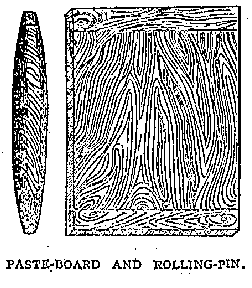
1187.
In mixing paste, add the water very gradually, work the whole together with the knife-blade, and knead it until perfectly smooth. Those who are inexperienced in pastry-making, should work the butter in by breaking it in small pieces and covering the paste rolled out. It should then be dredged with flour, and the ends folded over and rolled out very thin again: this process must be repeated until all the butter is used.1188. 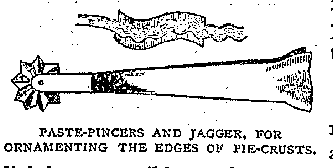
1189.
To insure rich paste being light, great expedition must be used in the making and baking; for if it stand long before it is put in the oven, it becomes flat and heavy.
1190.
Puff-paste requires a brisk oven, but not too hot, or it would blacken the crust; on the other hand, if the oven be too slack, the paste will be soddened, and will not rise, nor will it have any colour.
Tart-tins, cake-moulds, dishes for baked puddings, pattypans, &c., should all be buttered before the article intended to be baked is put in them: things to be baked on sheets should be placed on buttered paper. Raised-pie paste should have a soaking heat, and paste glazed must have rather a slack oven, that the icing be not scorched. It is better to ice tarts, &c. when they are three-parts baked.

1191.
To ascertain when the oven is heated to the proper degree for puff-paste, put a small piece of the paste in previous to baking the whole, and then the heat can thus be judged of.1192.
The freshness of all pudding ingredients is of much importance, as one bad article will taint the whole mixture.1193.
When the freshness of eggs is doubtful, break each one separately in a cup, before mixing them altogether. Should there be a bad one amongst them, it can be thrown away; whereas, if mixed with the good ones, the entire quantity would be spoiled. The yolks and whites beaten separately make the articles they are put into much lighter.1194.
Raisins and dried fruits for puddings should be carefully picked, and, in many cases, stoned. Currants should be well washed, pressed in a cloth, and placed on a dish before the fire to get thoroughly dry; they should then be picked carefully over, and every piece of grit or stone removed from amongst them. To plump them, some cooks pour boiling water over them, and then dry them before the fire.1195.
Batter pudding should be smoothly mixed and free from lumps. To insure this, first mix the flour with a very small proportion of milk, and add the remainder by degrees. Should the pudding be very lumpy, it may be strained through a hair sieve.1196.
All boiled puddings should be put on in boiling water, which must not be allowed to stop simmering, and the pudding must always be covered with the water; if requisite, the saucepan should be kept filled up.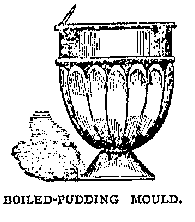
1197.
To prevent a pudding boiled in a cloth from sticking to the bottom of the saucepan, place a small plate or saucer underneath it, and set the pan on a trivet over the fire. If a mould is used, this precaution is not necessary; but care must be taken to keep the pudding well covered with water.1198.
For dishing a boiled pudding as soon as it comes out of the pot, dip it into a basin of cold water, and the cloth will then not adhere to it. Great expedition is necessary in sending puddings to table, as, by standing, they quickly become heavy, batter puddings particularly.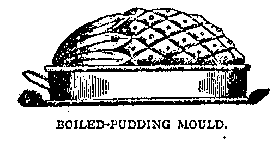 1199. For baked or boiled puddings, the moulds, cups, or basins, should be always buttered before the mixture is put in them, and they should be put into the saucepan directly they are filled.
1199. For baked or boiled puddings, the moulds, cups, or basins, should be always buttered before the mixture is put in them, and they should be put into the saucepan directly they are filled.
1200.
Scrupulous attention should be paid to the cleanliness of pudding-cloths, as, from neglect in this particular, the outsides of boiled puddings frequently taste very disagreeably. As soon as possible after it is taken off the pudding, it should be soaked in water, and then well washed, without soap, unless it be very greasy. It should be dried out of doors, then folded up and kept in a dry place. When wanted for use, dip it in boiling water, and dredge it slightly with flour.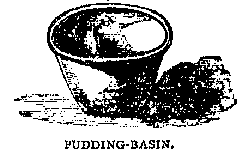
1201.
The dry ingredients for puddings are better for being mixed some time before they are wanted; the liquid portion should only be added just before the pudding is put into the saucepan.1202.
A pinch of salt is an improvement to the generality of puddings; but this ingredient should be added very sparingly, as the flavour should not be detected.1203.
When baked puddings are sufficiently solid, turn them out of the dish they were baked in, bottom uppermost, and strew over them fine sifted sugar.1204.
When pastry or baked puddings are not done through, and yet the outside is sufficiently brown, cover them over with a piece of white paper until thoroughly cooked: this prevents them from getting burnt.
